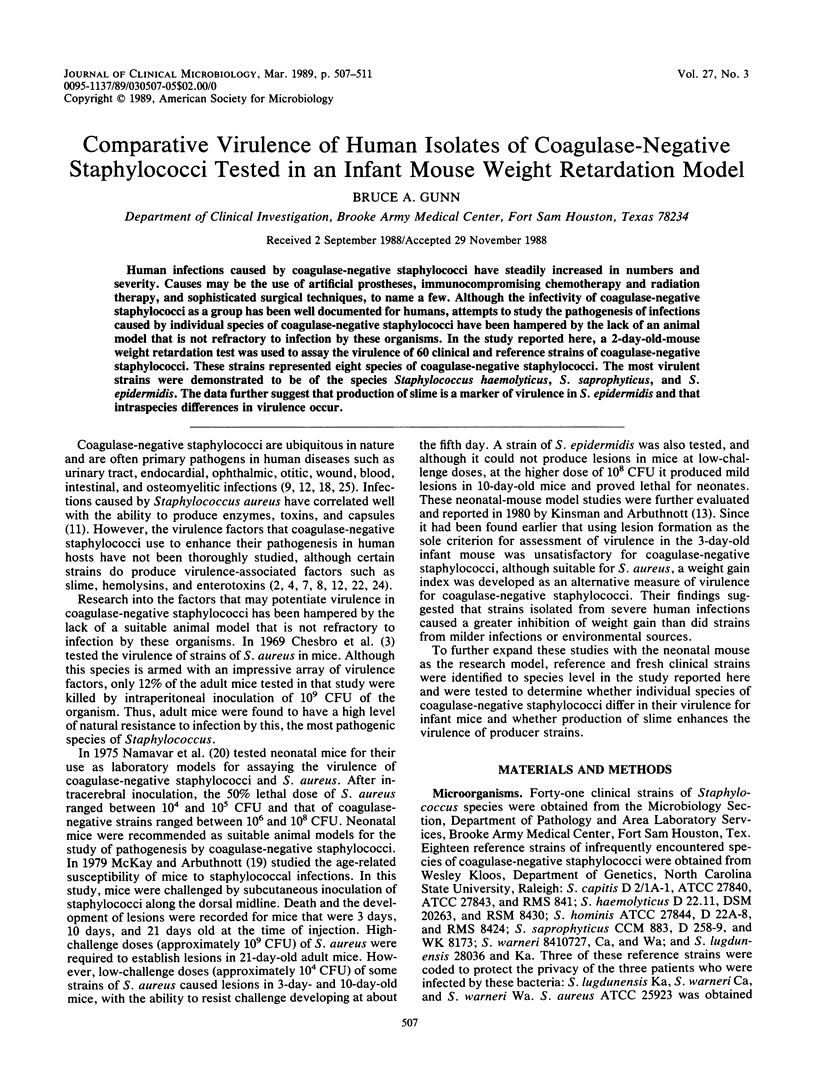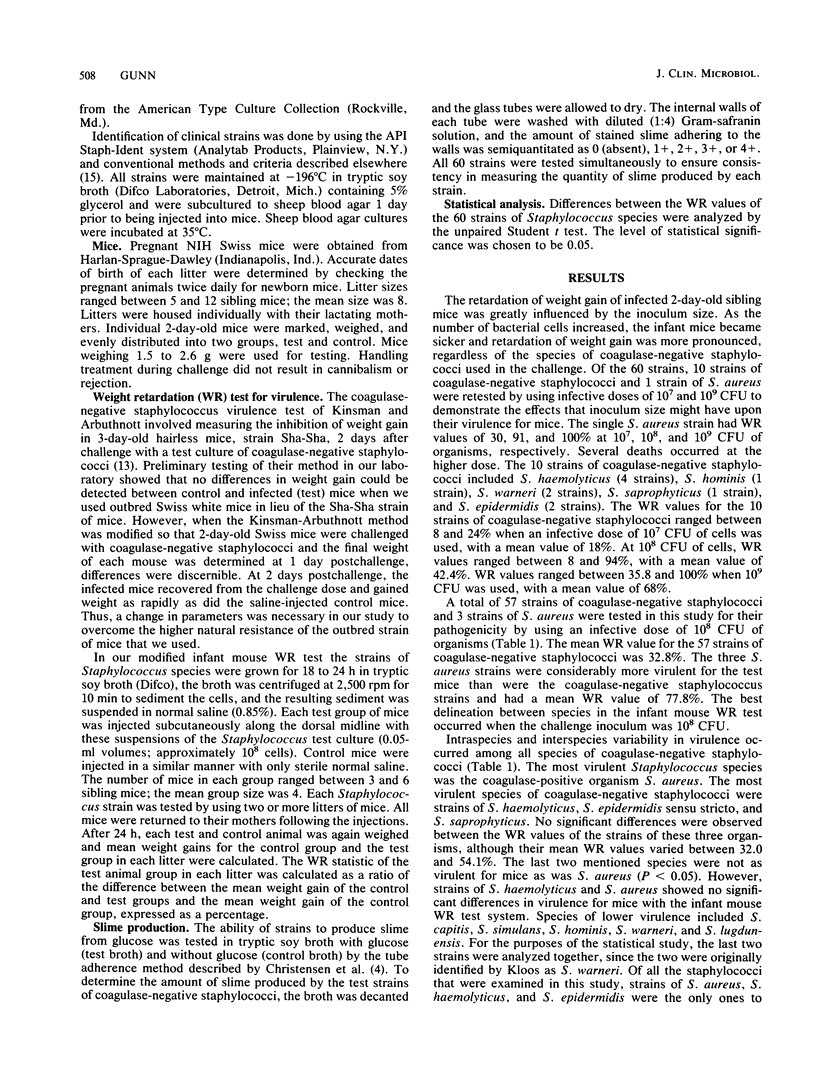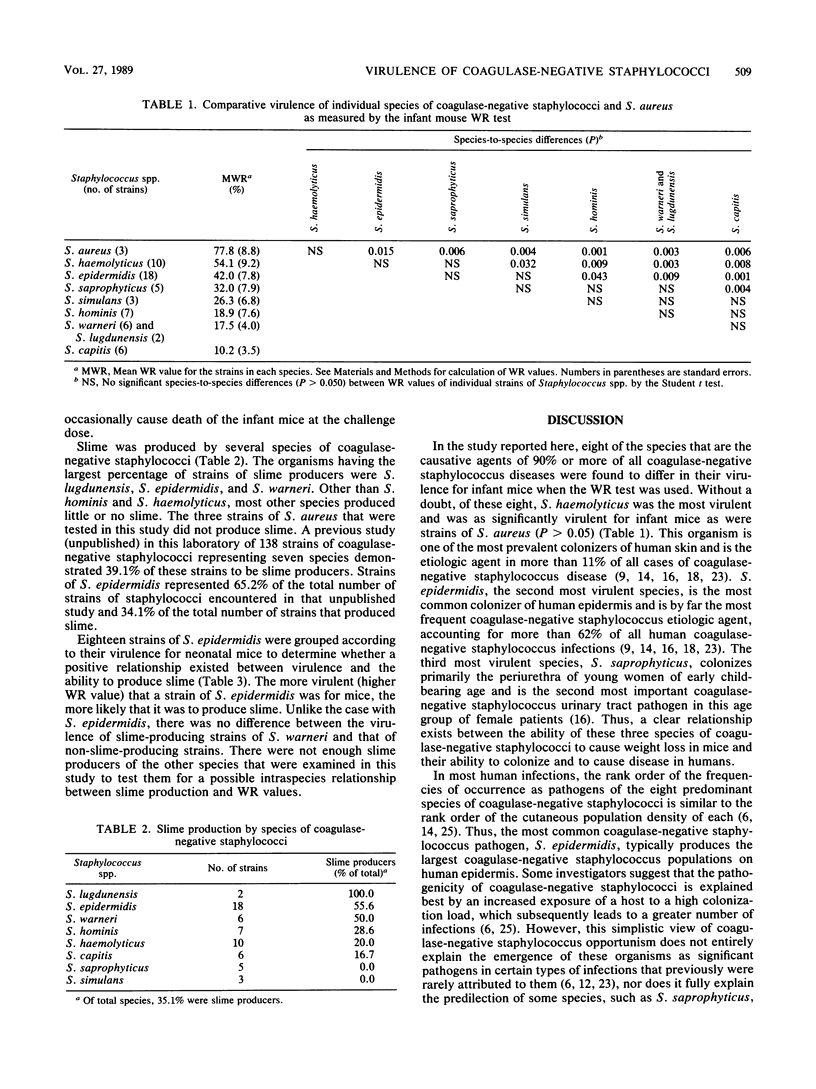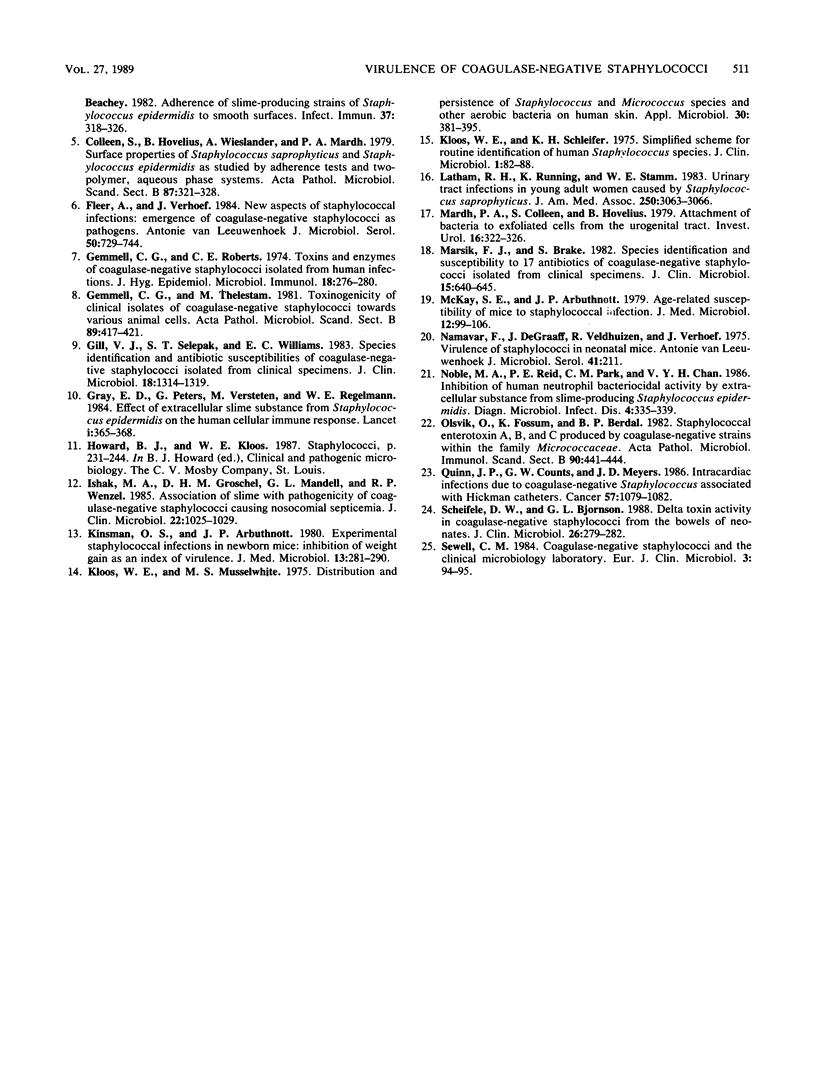Abstract
Human infections caused by coagulase-negative staphylococci have steadily increased in numbers and severity. Causes may be the use of artificial prostheses, immunocompromising chemotherapy and radiation therapy, and sophisticated surgical techniques, to name a few. Although the infectivity of coagulase-negative staphylococci as a group has been well documented for humans, attempts to study the pathogenesis of infections caused by individual species of coagulase-negative staphylococci have been hampered by the lack of an animal model that is not refractory to infection by these organisms. In the study reported here, a 2-day-old-mouse weight retardation test was used to assay the virulence of 60 clinical and reference strains of coagulase-negative staphylococci. These strains represented eight species of coagulase-negative staphylococci. The most virulent strains were demonstrated to be of the species Staphylococcus haemolyticus, S. saprophyticus, and S. epidermidis. The data further suggest that production of slime is a marker of virulence in S. epidermidis and that intraspecies differences in virulence occur.
Full text
PDF




Selected References
These references are in PubMed. This may not be the complete list of references from this article.
- Baddour L. M., Christensen G. D., Hester M. G., Bisno A. L. Production of experimental endocarditis by coagulase-negative staphylococci: variability in species virulence. J Infect Dis. 1984 Nov;150(5):721–727. doi: 10.1093/infdis/150.5.721. [DOI] [PubMed] [Google Scholar]
- Chesbro W. R., Wamola I., Bartley C. H. Correlation of virulence with growth rate in Staphylococcus aureus. Can J Microbiol. 1969 Jul;15(7):723–729. doi: 10.1139/m69-127. [DOI] [PubMed] [Google Scholar]
- Christensen G. D., Simpson W. A., Bisno A. L., Beachey E. H. Adherence of slime-producing strains of Staphylococcus epidermidis to smooth surfaces. Infect Immun. 1982 Jul;37(1):318–326. doi: 10.1128/iai.37.1.318-326.1982. [DOI] [PMC free article] [PubMed] [Google Scholar]
- Colleen S., Hovelius B., Wieslander A., Mårdh P. A. Surface properties of Staphylococcus saprophyticus and Staphylococcus epidermidis as studied by adherence tests and two-polymer, aqueous phase systems. Acta Pathol Microbiol Scand B. 1979 Dec;87(6):321–328. doi: 10.1111/j.1699-0463.1979.tb02446.x. [DOI] [PubMed] [Google Scholar]
- Fleer A., Verhoef J. New aspects of staphylococcal infections: emergence of coagulase-negative staphylococci as pathogens. Antonie Van Leeuwenhoek. 1984;50(5-6):729–744. doi: 10.1007/BF02386237. [DOI] [PubMed] [Google Scholar]
- Gemmell C. G., Roberts E. Toxins and enzymes of coagulase negative staphylococci isolated from human infections. J Hyg Epidemiol Microbiol Immunol. 1974;18(3):276–280. [PubMed] [Google Scholar]
- Gemmell C. G., Thelestam M. Toxinogenicity of clinical isolates of coagulase-negative staphylococci towards various animal cells. Acta Pathol Microbiol Scand B. 1981 Dec;89(6):417–421. [PubMed] [Google Scholar]
- Gill V. J., Selepak S. T., Williams E. C. Species identification and antibiotic susceptibilities of coagulase-negative staphylococci isolated from clinical specimens. J Clin Microbiol. 1983 Dec;18(6):1314–1319. doi: 10.1128/jcm.18.6.1314-1319.1983. [DOI] [PMC free article] [PubMed] [Google Scholar]
- Gray E. D., Peters G., Verstegen M., Regelmann W. E. Effect of extracellular slime substance from Staphylococcus epidermidis on the human cellular immune response. Lancet. 1984 Feb 18;1(8373):365–367. doi: 10.1016/s0140-6736(84)90413-6. [DOI] [PubMed] [Google Scholar]
- Ishak M. A., Gröschel D. H., Mandell G. L., Wenzel R. P. Association of slime with pathogenicity of coagulase-negative staphylococci causing nosocomial septicemia. J Clin Microbiol. 1985 Dec;22(6):1025–1029. doi: 10.1128/jcm.22.6.1025-1029.1985. [DOI] [PMC free article] [PubMed] [Google Scholar]
- Kinsman O. S., Arbuthnott J. P. Experimental staphylococcal infections in newborn mice: inhibition of weight gain as an index of virulence. J Med Microbiol. 1980 May;13(2):281–290. doi: 10.1099/00222615-13-2-281. [DOI] [PubMed] [Google Scholar]
- Kloos W. E., Musselwhite M. S. Distribution and persistence of Staphylococcus and Micrococcus species and other aerobic bacteria on human skin. Appl Microbiol. 1975 Sep;30(3):381–385. doi: 10.1128/am.30.3.381-395.1975. [DOI] [PMC free article] [PubMed] [Google Scholar]
- Kloos W. E., Schleifer K. H. Simplified scheme for routine identification of human Staphylococcus species. J Clin Microbiol. 1975 Jan;1(1):82–88. doi: 10.1128/jcm.1.1.82-88.1975. [DOI] [PMC free article] [PubMed] [Google Scholar]
- Latham R. H., Running K., Stamm W. E. Urinary tract infections in young adult women caused by Staphylococcus saprophyticus. JAMA. 1983 Dec 9;250(22):3063–3066. [PubMed] [Google Scholar]
- Marsik F. J., Brake S. Species identification and susceptibility to 17 antibiotics of coagulase-negative staphylococci isolated from clinical specimens. J Clin Microbiol. 1982 Apr;15(4):640–645. doi: 10.1128/jcm.15.4.640-645.1982. [DOI] [PMC free article] [PubMed] [Google Scholar]
- McKay S. E., Arbuthnott J. P. Age-related susceptibility of mice to staphylococcal infection. J Med Microbiol. 1979 Feb;12(1):99–106. doi: 10.1099/00222615-12-1-99. [DOI] [PubMed] [Google Scholar]
- Mårdh P. A., Colleen S., Hovelius B. Attachment of bacteria to exfoliated cells from the urogenital tract. Invest Urol. 1979 Mar;16(5):322–326. [PubMed] [Google Scholar]
- Namavar F., de Graaff J., Veldhuizen R., Verhoef J. Proceedings: Netherlands Society for Microbiology meeting of the medical section at Bilthoven on 10 October 1974. Virulence of staphylococci in neonatal mice. Antonie Van Leeuwenhoek. 1975;41(2):211–211. doi: 10.1007/BF02565053. [DOI] [PubMed] [Google Scholar]
- Noble M. A., Reid P. E., Park C. M., Chan V. Y. Inhibition of human neutrophil bacteriocidal activity by extracellular substance from slime-producing Staphylococcus epidermidis. Diagn Microbiol Infect Dis. 1986 Apr;4(4):335–339. doi: 10.1016/0732-8893(86)90074-x. [DOI] [PubMed] [Google Scholar]
- Olsvik O., Fossum K., Berdal B. P. Staphylococcal enterotoxin A, B, and C produced by coagulase-negative strains within the family Micrococcaceae. Acta Pathol Microbiol Immunol Scand B. 1982 Dec;90(6):441–444. doi: 10.1111/j.1699-0463.1982.tb00143.x. [DOI] [PubMed] [Google Scholar]
- Quinn J. P., Counts G. W., Meyers J. D. Intracardiac infections due to coagulase-negative Staphylococcus associated with Hickman catheters. Cancer. 1986 Mar 1;57(5):1079–1082. doi: 10.1002/1097-0142(19860301)57:5<1079::aid-cncr2820570536>3.0.co;2-x. [DOI] [PubMed] [Google Scholar]
- Scheifele D. W., Bjornson G. L. Delta toxin activity in coagulase-negative staphylococci from the bowels of neonates. J Clin Microbiol. 1988 Feb;26(2):279–282. doi: 10.1128/jcm.26.2.279-282.1988. [DOI] [PMC free article] [PubMed] [Google Scholar]


